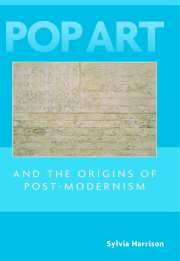Book contents
- Frontmatter
- Contents
- Introduction
- PART ONE THEORETICAL FRAMEWORK
- PART TWO “SOCIAL” CRITICS
- 2 Lawrence Alloway: Pop Art and the “Pop Art-Fine Art Continuum”
- 3 Harold Rosenberg: Pop Art and the “De-definition” of Both Art and “Self”
- 4 Leo Steinberg: Pop, “Post-Modernist” Painting and the Flatbed Picture Plane
- PART THREE “PHILOSOPHICAL” CRITICS
- PART FOUR “CULTURAL” CRITICS
- Conclusion
- Notes
- Index
2 - Lawrence Alloway: Pop Art and the “Pop Art-Fine Art Continuum”
from PART TWO - “SOCIAL” CRITICS
Published online by Cambridge University Press: 23 July 2009
- Frontmatter
- Contents
- Introduction
- PART ONE THEORETICAL FRAMEWORK
- PART TWO “SOCIAL” CRITICS
- 2 Lawrence Alloway: Pop Art and the “Pop Art-Fine Art Continuum”
- 3 Harold Rosenberg: Pop Art and the “De-definition” of Both Art and “Self”
- 4 Leo Steinberg: Pop, “Post-Modernist” Painting and the Flatbed Picture Plane
- PART THREE “PHILOSOPHICAL” CRITICS
- PART FOUR “CULTURAL” CRITICS
- Conclusion
- Notes
- Index
Summary
Lawrence Alloway, Harold Rosenberg, and Leo Steinberg are united by a common, if broadly defined, methodological approach to pop art. It was one that sought to explain the iconographic, stylistic, and formal features of this movement in terms of the deconstructive effect of key technological and economic characteristics of post-war Western urban society: mass communications and capitalist consumerism. In seeking authority for this approach, these critics discredited, if in varying ways, the prevailing modernist paradigm of Greenbergian formalism as well as the traditional representational paradigm in both the art and literature of realism.
Within this area of consensus each critic presented a distinct argument concerning the perceived bond between pop art and the deconstructive character of mass communications and consumerism. Rosenberg regarded pop as evidence of the “de-definition” of art; Alloway saw it as a mirror of the spectrum of visual communications as well as representative of a constitutive channel (painting) and, in its communicative function, as equally “de-defined”; Steinberg identified the “flatbed” picture plane as that characteristic of “post-Modernist” painting, including pop. Steinberg's case, as with Alloway's, centres on the pop artists' use of pre-existing signs disseminated by mass communications in the post-war period as well as on the role played by these signs in the creation of a mediate world. It is, however, more theoretical and more rigorously medium-specific, its credibility dependent on “deconstructing” Greenberg's distinction between the types of illusion inherent in modernist and traditional painting.
- Type
- Chapter
- Information
- Pop Art and the Origins of Post-Modernism , pp. 37 - 67Publisher: Cambridge University PressPrint publication year: 2001



